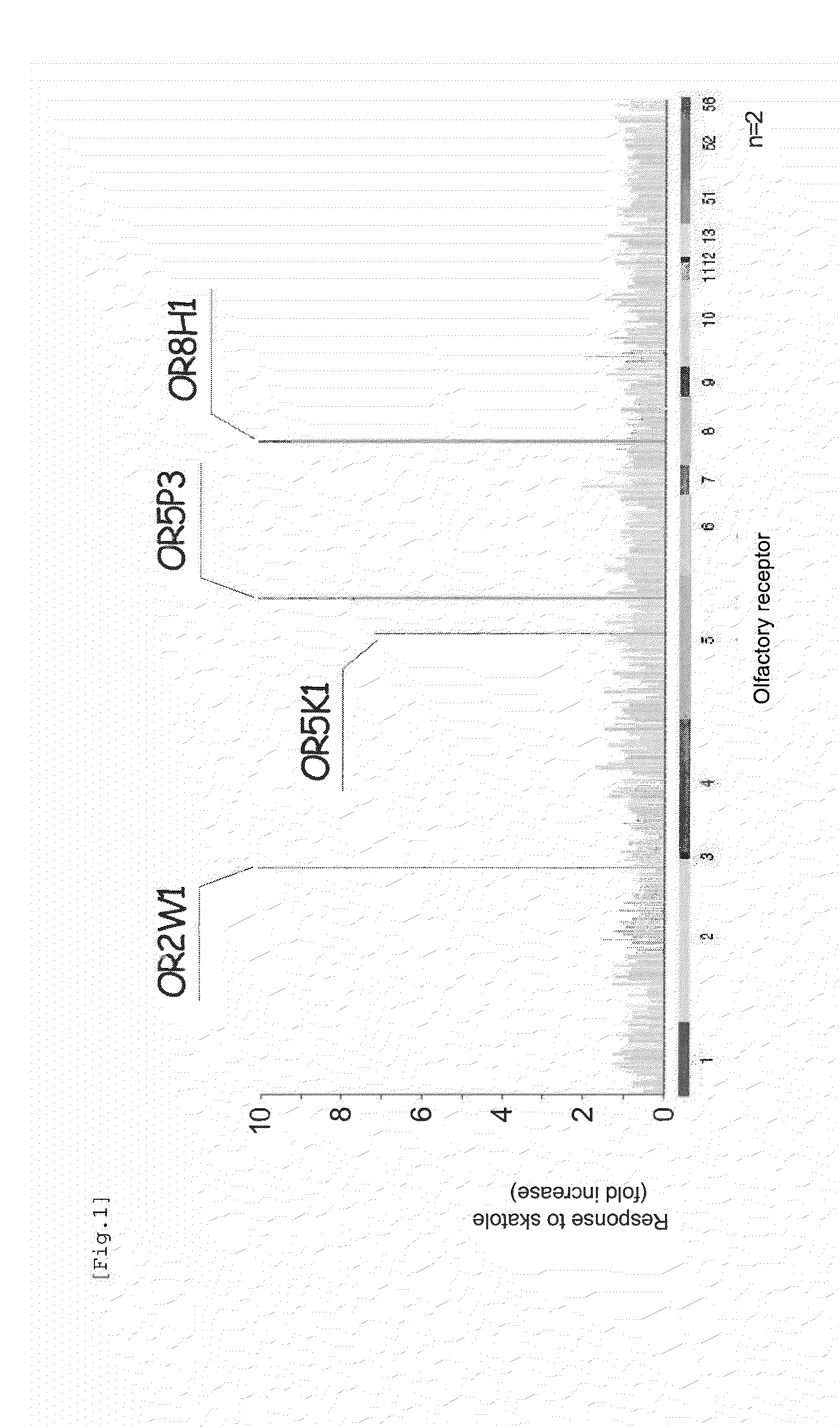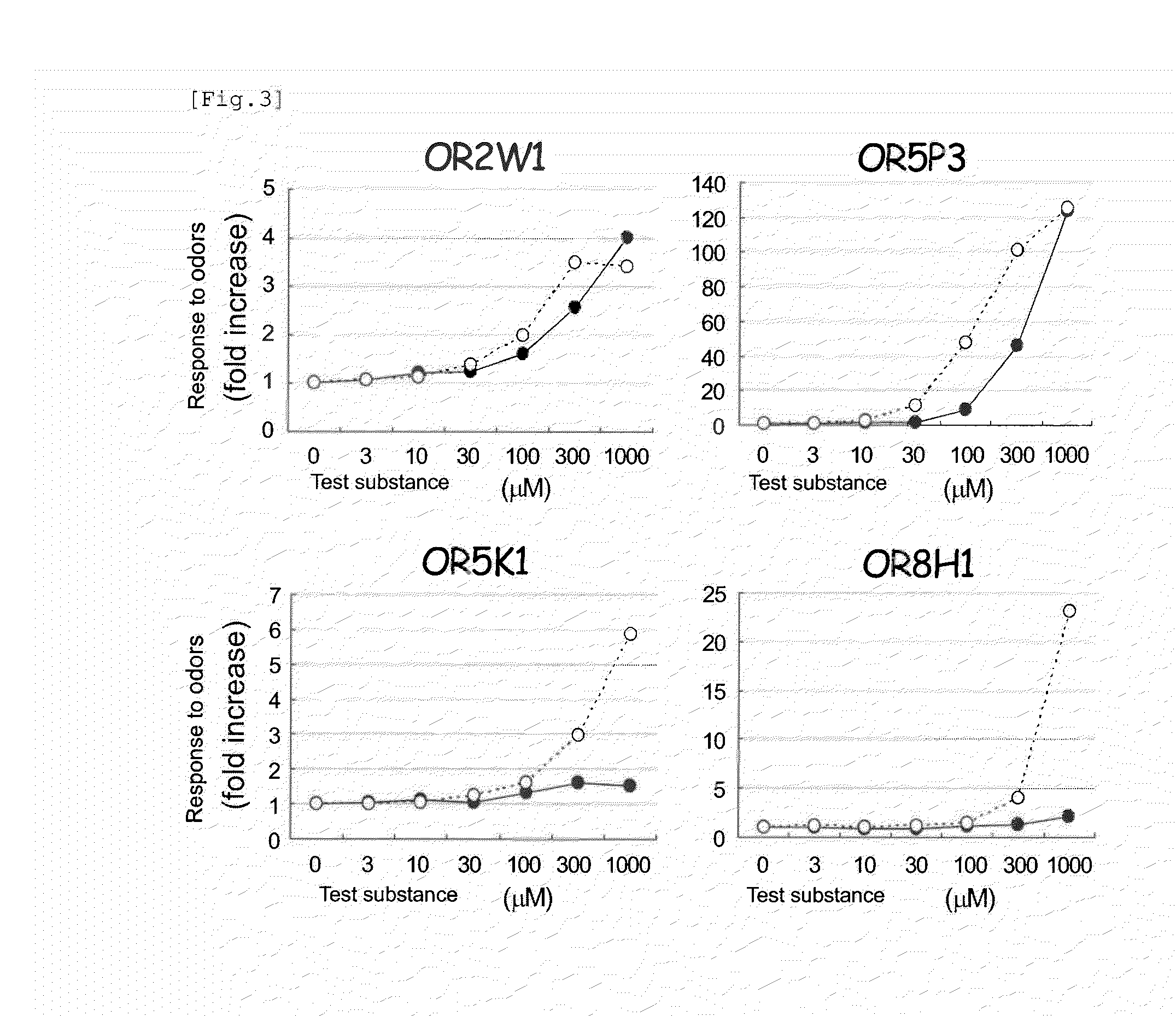Method for Identifying a Malodor Inhibitor
a malodor inhibitor and malodor technology, applied in the field of malodor inhibitors, can solve the problems of malodorous molecules, acids and skatole, which cannot be reduced through known malodor reducing techniques, and fecal odor and foul breath are particularly unpleasant odors, and achieve the effect of suppressing the response of the olfactory receptor
- Summary
- Abstract
- Description
- Claims
- Application Information
AI Technical Summary
Benefits of technology
Problems solved by technology
Method used
Image
Examples
example 1
Identification of Olfactory Receptors to Malodors
(1) Cloning of Human Olfactory Receptor Genes
[0049]Cloning of human olfactory receptors was performed based on the sequence information registered in GenBank, through PCR with human genomic DNA female (G1521: Promega) as a template. Each of the genes amplified through PCR was inserted into a pENTR vector (Invitrogen) according to an instruction manual. Then, the gene-inserted vector was digested with NotI and AscI, and the obtained fragments were inserted into NotI and AscI sites located downstream of the Flag-Rho tag sequence in the pME18S vector.
(2) Production of pME18S-RTP1S Vector
[0050]Cloning of human RTP1S was performed through PCR with a human RTP1 gene (MHS1010-9205862: Open Biosystems) as a template. EcoRI site was added to the forward primer employed in PCR, and XhoI site was added to the reverse primer. A hRTP1S gene (SEQ ID NO: 9) was amplified through PCR and inserted into EcoRI and XhoI site of the pME18S vector.
[0051]In...
example 2
Dose-Dependent Response of Skatole Receptor
[0057]In a manner similar to that employed in Example 1, each of olfactory receptor OR2W1 (SEQ ID NO: 2), OR5K1 (SEQ ID NO: 4), OR5P3 (SEQ ID NO: 6), and OR8H1 (SEQ ID NO: 8) was expressed with RTP1S mutant (SEQ ID NO: 12) in HEK293 cells. The response of each receptor to skatole (0, 3, 10, 30, 100, 300, and 1000 μM) was determined. As a result, all of the four olfactory receptors exhibited a dose-dependent response to skatole (FIG. 2)
example 3
Response of Receptor to Skatole and Indole
[0058]In a manner similar to that employed in Example 2, the response of each olfactory receptor to skatole and indole (each 0, 3, 10, 30, 100, 300, and 1000 μM) was determined. As a result, these olfactory receptors exhibited a response not only to skatole but also to indole (FIG. 3).
PUM
| Property | Measurement | Unit |
|---|---|---|
| molecular weights | aaaaa | aaaaa |
| polarity | aaaaa | aaaaa |
| adsorption | aaaaa | aaaaa |
Abstract
Description
Claims
Application Information
 Login to View More
Login to View More - R&D
- Intellectual Property
- Life Sciences
- Materials
- Tech Scout
- Unparalleled Data Quality
- Higher Quality Content
- 60% Fewer Hallucinations
Browse by: Latest US Patents, China's latest patents, Technical Efficacy Thesaurus, Application Domain, Technology Topic, Popular Technical Reports.
© 2025 PatSnap. All rights reserved.Legal|Privacy policy|Modern Slavery Act Transparency Statement|Sitemap|About US| Contact US: help@patsnap.com



